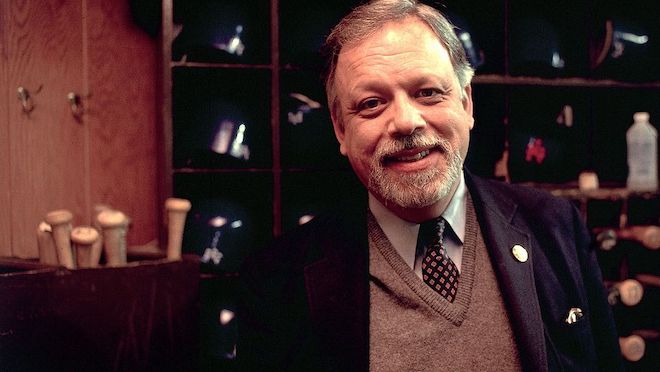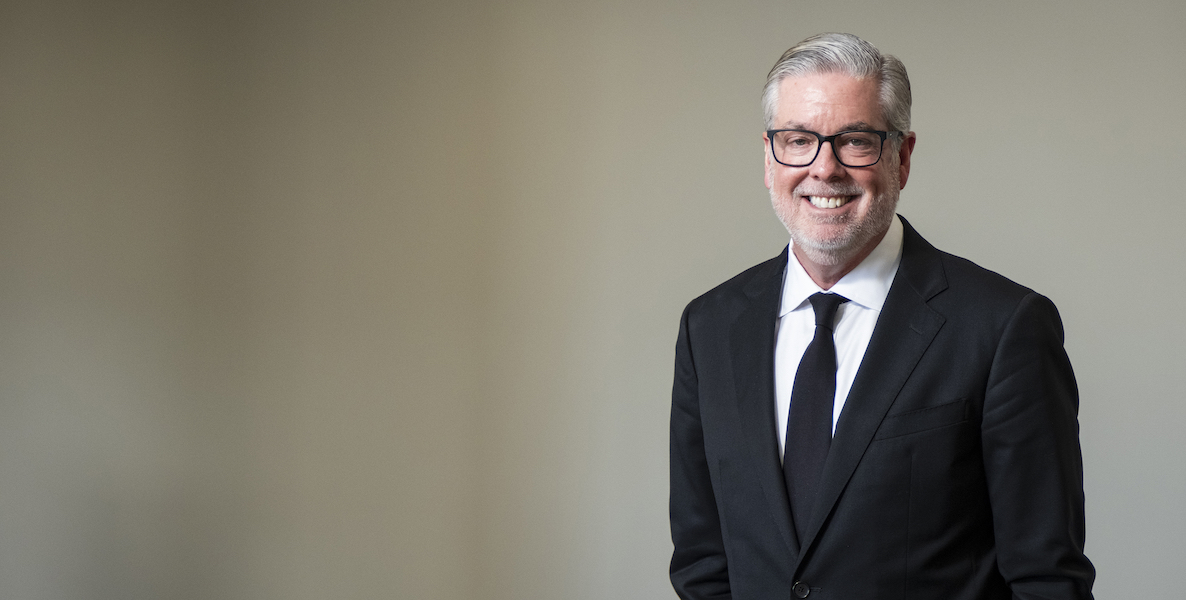If, like me, you’ve been looking for reasons to be hopeful in these weird and getting weirder times, you maybe felt an unfamiliar sweep of cheerfulness upon hearing of Temple University’s bold new hire for its president: John Fry, who, at Drexel University, University of Pennsylvania and even Franklin & Marshall College over the last couple of decades, has, thanks to rose-colored vision, stretched the very notion of what it means to lead a university.
Yes, Fry has served as an institutional leader, but he’s also been an urban planner, real estate developer, civic cheerleader, and behind-the-scenes power macher. An MBA, he’s no sequestered ivory tower academic.
And now he brings his uniquely engaged approach to Temple University, our true city university, with all its diversity and grit and aspiration and local tradition. To be Temple-made — as my father was, before dropping out during World War II to, as he would say, “protect the shores of Seattle from Japanese attack” — is a unique and powerful thing; to make Philadelphia Temple-made, which is what the Fry era portends, has the potential to change the very ethos of our self-identity. Gone could be the Philly Shrug; it could be a new era of Yes, We Can.
When he became Drexel’s President, Fry proclaimed his north star: To make the school “the most civically engaged university in the nation.” Fast-forward to 2024, and damn if he didn’t do just that.
Everywhere Fry has gone, he’s helped stir economic comeback. Where better, then, for a next act than North Philly? As executive vice president at Penn, Fry was instrumental in connecting the insular Ivy League academy to its surrounding environs. Fry recruited disparate West Philly groups (partnering with, among others, a mulleted young campus apartment developer named David Adelman) to create the University City District, addressing quality of life issues. He invested in the K-8 Penn Alexander School, a groundbreaking example of private/public school partnership. He founded an employee home purchase program, so those who worked at Penn could also live among the school’s neighbors.
When he became Drexel’s President in 2010, Fry proclaimed his north star: To make the school “the most civically engaged university in the nation.” Fast-forward to 2024, and damn if he didn’t do just that. He brought in an all-star of civic thinkers and doers — Lucy Kerman, Harris Steinberg, Michael O’Bryan and Bruce Katz among them — and made “Introduction to Civic Engagement” a mandatory first-year undergraduate course. When there was a civic emergency — the futures, respectively, of the Atwater Kent Museum collection or St. Christopher’s Hospital come to mind — there was Fry, thinking beyond the short-term needs of his own university. Under Fry, The Lindy Center for Civic Engagement placed armies of do-gooding students, staff and faculty alike in community hot spots, and Steinberg’s Lindy Institute for Urban Innovation advanced solutions to longstanding urban challenges.
What Temple under Fry can do for us
Amid all the fanfare of Fry’s recent appointment, this is what has been missed: It’s not about what Fry as president will do for Temple University; it’s about what Temple University under Fry can do for the rest of us. Those who grouse that he’s not an academic, or, worse, that he’s just some kind of glorified real estate developer, are missing the point: Fry is a communitarian who sees the power of the university as serving all around it.
It’s a lesson straight from our mutual hero, about whom Fry and I have long compared notes: the late, legendary Yale University President (and former Major League Baseball Commissioner) Bart Giamatti. You might know Giamatti, vaguely, as the sire of one of this generation’s great actors. In fact, he was one of the 20th century’s leading lights. Once, Fry pointed me to a line in Giamatti’s 1989 New York Times obituary: “My goal has been to encourage jointness, to push people to think of affiliations rather than to operate as solo entrepreneurs.”

Giamatti, ironically, was an academic, an Ivy League professor of Renaissance literature who was a surprising choice to be Yale’s president at all of 39 years old in 1979. I first came to him through baseball; even before his stint as Commissioner (he died, at 51, of a heart attack after only five months on the job, shortly after banning Pete Rose from baseball for betting on the game), his treatises on the national pastime were beautiful, and called to national unity. Here he is on the great pitcher Tom Seaver:
In bars in Queens, in clubs in the Bronx, in living rooms in front of Channel Nine in Suffolk and Nassau, out on Staten Island, everywhere, but particularly in the tattered reaches of Shea Stadium, they loved him for many things, but above all because he never thought he had to throw at anybody’s head. From the Columbia riots to the brink of fiscal disaster, there was someone in New York who did not throw at anybody. They loved it in him, and in that act sought for it in themselves.
Giamatti brought the same sense of romanticism to running a university as he did to baseball, which is how Fry came to be enamored of him. Giamatti took on Yale’s tradition of building “leaders” by proclaiming they were really in the business of producing citizens. Check out this stirring endorsement of Enlightenment values from a 1983 speech to the incoming freshman class:
A liberal education has nothing to do with those political designer labels liberal and conservative. Nor is it one that seeks to implant the precepts of a specific religious or political orthodoxy … Education occurs when you pursue knowledge because you are motivated to experience and absorb what comes of thinking … [It] embraces physics as well as French, lasers as well as literature, social science, and physical and biological sciences as well as the arts and humanities … You will not be impeded from making a living because you have learned to think for yourself and because you take pleasure in the operation of the mind in the pursuit of new ideas.
Fry and I have bonded over such highfalutin rhetoric, both of us wishing we’d known this guy. One day, as recounted in Sports Illustrated when Giamatti became commissioner, he received a letter from 7th-grader Kempton Dunn of New Canaan, Connecticut, who wanted to know why the Yale president thought learning the antiquated language of Latin was so important. Giamatti penned a veritable essay in reply, concluding with: “We study Latin because without it we cannot know our history and our heritage. And without that knowledge, we cannot know ourselves. Nosce teipsum [know thyself], brave Dunn.”
A perch from which to marshall problem-solvers
Fry’s commitment to civic engagement — and to that idea of getting there through “jointness” — is rooted in Giamatti’s groundbreaking stewardship of Yale’s relationship to its home city. In his 1978 inaugural address, Giamatti proclaimed that “Our future is entwined with New Haven’s … The only attitude that will reflect reality is one of mutual regard and collaboration.”
Gone were the days when Yale haughtily barricaded itself from its fellow citizens. Giamatti established scholarships for New Haven high school grads and founded the Yale-New Haven Teachers Institute to reconnect Yale to the city’s public schools. He struck up a partnership with New Haven Mayor Biagio DiLieto, inviting the mayor to address Yale’s students. In short order, their partnership transformed both Yale and the city, as outlined by Giamatti biographer Neil Thomas Proto:
Giamatti had DiLieto’s Development Administrator John Sawyer encourage Yale Corporation members to invest in New Haven. DiLieto sought a dedicated investment fund, acknowledged publicly as $750 million, to restore New Haven’s tax base. Giamatti encouraged Yale hospital’s aid in financing concentrated parking; partnered to transform the Winchester factory complex into the “New Haven Science Park” to “stabilize” the neighborhood; ensured the city could acquire Yale property, below market price, on Whitney and Grove Streets for taxable projects; provided loans for Taft Hotel renovation; invested in Chapel Square Mall renovation; and … supported New Haven’s economic and civil rights battle against the proposed North Haven Mall …
Now, word of caution: Temple is no Yale in terms of endowment or influence, so don’t expect some kind of bailout, Mayor Parker. And Fry, ever the collaborator, will rightly resist the White savior mantle. But I’ve long maintained that the city’s institutions of higher learning ought to be major players at the civic problem-solving table, deploying their best and brightest in an act of ongoing local patriotism. Fry will now have a prominent perch from which to marshall those forces.
“If pluralism as a concept denies anything, it denies the hegemony of the homogeneous, the rule by a single, overmastering sensibility which would exclude all those who are different from the general benefits of citizenship.” — Bart Giametti
Biographer Proto writes that Giamatti never dealt “with any person in an ad hominem way” — like Fry, civility was a core value — but the parallels between Fry and Giamatti don’t all line up, of course. Fry, for example, is far less publicly controversial. (Some hoped his tenure as chair of the Greater Philadelphia Chamber of Commerce would be more disruptive than it turned out to be.) Giamatti, on the other hand, could be a strident moralist and public scold. His 1981 letter to students attacking the Moral Majority — the Rev. Jerry Falwell and his Christian fundamentalist flock — upset donors and board members alike, but it speaks to us today like a clarion call through the ages:
Angry at change, rigid in the application of chauvinistic slogans, absolutistic in morality, they threaten through political pressure of public denunciation whoever dares to disagree with their authoritarian positions … From the maw of this ”morality” come those who presume to know what justice for all is; come those who presume to know which books are fit to read, which television programs are fit to watch, which textbooks will serve for all the young; come spilling those who presume to know what God alone knows, which is when human life begins. From the maw of this ”morality” rise the tax-exempt Savanarolas who believe they, and they alone, possess the truth … What dangerous, malicious nonsense. What a shame more of our captains of commerce have not seized the opportunity to speak up for free enterprise. What a shame such denials of our country’s deepest traditions of freedom of thought, speech, creed and choice are not faced candidly in open debate by our political and religious leaders. What a shame more of those from various parts of the society with the responsibility to lead have not made the point, clearly and unambiguously, that such beliefs have every right to be expressed but not to be imposed by intimidation.
And then Giamatti concluded with this stirring defense of pluralism, and in it you can feel the sum total of John Fry’s life and work:
Pluralism is not relativism. It does not mean the denial of absolutes or the absence of standards. Pluralism is not code for anything. It signals the recognition that people of different ethnic groups and races and adherents of various religious and political and personal beliefs have a right to coexist as equals under the law and have an obligation to forge the freedoms they enjoy into a coherent, civilized and vigilant whole … If pluralism as a concept denies anything, it denies the hegemony of the homogeneous, the rule by a single, overmastering sensibility which would exclude all those who are different from the general benefits of citizenship.
The general benefits of citizenship. Their preservation — for all — really is our common project in this perilous moment, isn’t it? From North Philly will now come the call to tackle that challenge. Each of us, together, finally.
![]() MORE ON PHILLY’S HIGHER ED INSTITUTIONS
MORE ON PHILLY’S HIGHER ED INSTITUTIONS




